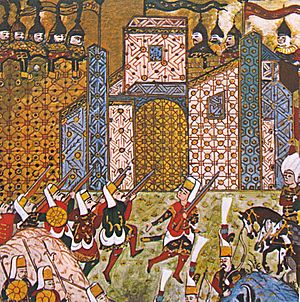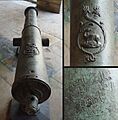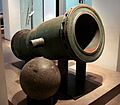Siege of Rhodes (1522) facts for kids
Quick facts for kids Siege of Rhodes |
|||||||
|---|---|---|---|---|---|---|---|
| Part of the Ottoman wars in Europe | |||||||
 Gun-wielding Ottoman Janissaries and defending Knights of Saint John at the siege of Rhodes, miniature from Süleymannâme |
|||||||
|
|||||||
| Belligerents | |||||||
| Commanders and leaders | |||||||
| Suleiman the Magnificent Çoban Mustafa Pasha Kurtoğlu Muslihiddin Reis |
Philippe Villiers de L'Isle-Adam | ||||||
| Strength | |||||||
| 180,000–100,000 men 400 ships 72 guns and mortars |
6,703 men (703 Knights Hospitallers of St. John, including men from Spain, France, Germany, Italy, England, and Portugal) |
||||||
| Casualties and losses | |||||||
| 60,000 dead Christian claims: 114,000 dead (50,000 from disease & 64,000 from battle) |
5,020 dead | ||||||
The Siege of Rhodes in 1522 was a big battle where the Ottoman Empire tried to take control of the island of Rhodes. They wanted to remove the Knights of Rhodes from their strong island base. This would help the Ottomans control the eastern part of the Mediterranean Sea.
The Ottomans had tried to capture Rhodes before, in 1480, but they failed. This time, even though Rhodes had very strong defenses, the Ottoman army used powerful cannons and dug tunnels to break down the city walls over six months.
Contents
Rhodes: The Knights' Island Home
The Knights of St. John, also known as the Knights Hospitallers, took over Rhodes in the early 1300s. This happened after they lost Acre in 1291, which was their last stronghold in Palestine. From Rhodes, the Knights became very active in trade across the Aegean Sea. They sometimes attacked Turkish ships in the Levant area. This helped them keep control over the eastern Mediterranean.
The Knights had already fought off an Ottoman attack in 1480. But having the Knights so close to the southern coast of Anatolia (modern-day Turkey) was a big problem for the Ottoman Empire. An earthquake hit the island in 1481, causing some damage.
Making the Walls Stronger
After the first siege and the earthquake, the fortress of Rhodes was made much stronger. New building methods, called trace italienne, were used to protect against cannons. The main walls were made thicker, and the dry ditch around the city was made twice as wide. Old outer defenses were turned into huge new strongholds called tenailles. Many towers got bulwarks (strong, projecting parts of a fort), and special passages called caponiers were built to protect the ditch.
The number of gates was reduced. The old battlements (the top parts of walls with openings for shooting) were replaced with slanting ones, which were better for fighting with cannons. Teams of builders, workers, and slaves did this construction. Muslim slaves were often given the hardest jobs.
Getting Ready for Battle
In 1521, Philippe Villiers de L'Isle-Adam became the Grand Master of the Knights. He expected a new Ottoman attack on Rhodes. So, he kept making the city's defenses stronger. He also asked other Knights in Europe to come help defend the island. Sadly, most of Europe did not send help. Only Sir John Rawson, from the Knights' Irish branch, came alone.
The city was protected by two, and in some places three, rings of stone walls and several large bastions. Different groups of Knights, called Langues, were given different parts of the defense. The entrance to the harbor was blocked by a heavy iron chain. The Knights' ships were anchored safely behind it.
The Ottoman Sultan, Suleiman, was convinced to attack Rhodes by his advisor, Piri Mehmed Pasha. Piri, along with Çoban and Kurtoğlu, attended important meetings. Piri urged the Sultan to attack Rhodes quickly.
The Ottoman Invasion Begins

The Turkish invasion force arrived at Rhodes on June 26, 1522. It included 400 ships and was led by Çoban Mustafa Pasha. Sultan Suleiman himself arrived with an army of 100,000 men on July 28 to take charge of the siege.
The Turks blocked the harbor and fired cannons at the city from the land side. They also launched almost daily attacks with their soldiers. The Ottomans also tried to weaken the city's defenses by digging tunnels and setting off mines under the walls. The cannon fire slowly damaged the strong walls.
Breaking Through the Walls
After five weeks, on September 4, two large gunpowder mines exploded under the Bastion of England. This caused a 12-yard section of the wall to fall into the moat. The Ottoman attackers immediately rushed into this gap and quickly took control of it. However, the English and German Knights, led by Fra' Nicholas Hussey and Grand Master Villiers de L'Isle-Adam, fought back hard and pushed them out. The Turks attacked this broken wall two more times that day, but the Knights held their ground.
On September 24, Mustafa Pasha ordered a huge attack on the bastions of Spain, England, Provence, and Italy. After a day of fierce fighting, where the Bastion of Spain was captured and then recaptured, Sultan Suleiman finally called off the attack. He was so angry that he sentenced Mustafa Pasha, who was his brother-in-law, to death for failing to take the city. But other officials begged him to change his mind, and Suleiman spared Mustafa's life.
Mustafa's replacement, Ahmed Pasha, was an expert in sieges. The Turks then focused on digging under the walls and blowing them up with mines. They also kept up their constant cannon attacks. It is thought that the Turkish miners might have used old underground passages from the ancient city of Rhodes to place their mines.
The Final Days
Another big attack at the end of November was also stopped by the Knights. But both sides were now very tired. The Knights were running out of strength, and no help was coming from Europe. The Turkish soldiers were also losing hope and many were dying from fighting and disease.
Suleiman offered the defenders a chance for peace. He promised them their lives and food if they surrendered. But he warned that if the Turks had to take the city by force, they would face death or slavery. The people of Rhodes urged Grand Master Villiers de L'Isle-Adam to agree to talk. A truce (a temporary stop to fighting) was called from December 11 to 13 for negotiations. But when the local people asked for more promises about their safety, Suleiman became angry. He ordered the cannon fire and attacks to start again.
The Bastion of Spain fell on December 17. With most of the walls now destroyed, it was clear the city would soon have to give up. On December 20, after several days of pressure from the townspeople, the Grand Master asked for another truce.
The End of the Siege
On December 22, representatives from the Latin and Greek people of Rhodes accepted Suleiman's terms. His terms were quite fair. The Knights were given twelve days to leave the island. They were allowed to take their weapons, valuable items, and religious symbols. Islanders who wanted to leave could do so anytime within three years. No church would be damaged or turned into a mosque. Those who stayed on the island would not have to pay Ottoman taxes for five years.
On January 1, 1523, the remaining Knights and soldiers marched out of the town. Their flags were flying, drums were beating, and they wore their battle armor. They boarded 50 ships that had been provided for them and sailed to Crete, which was controlled by Venice. Several thousand civilians went with them.
What Happened Next
The Siege of Rhodes ended with a victory for the Ottoman Empire. Taking control of Rhodes was a very important step for the Ottomans. It helped them control the eastern Mediterranean Sea and made it much easier for their ships to travel between Constantinople, Cairo, and other important ports. Much later, in 1669, the Ottomans used this control to capture Venetian Crete.
The Knights Hospitaller first moved to Sicily. But in 1530, Emperor Charles V gave them the islands of Malta, Gozo, and the North African port city of Tripoli. This happened after an agreement with Pope Clement VII, who was also a Knight.
Images for kids
-
A large cannon of Francis I of France with a salamander symbol and Ottoman Turkish writing. It was used during the Siege of Rhodes (1522).
-
A bombard-mortar used by the Knights of Saint John in Rhodes, from 1480–1500. It fired heavy granite balls and was used for close defense of the walls.
-
A culverin (a type of cannon) with the symbols of Philippe Villiers de L'Isle-Adam. This cannon was later given to Napoleon III in 1862.
See also
- List of campaigns of Suleiman the Magnificent







